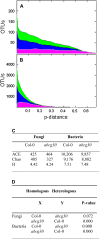An ABC transporter mutation alters root exudation of phytochemicals that provoke an overhaul of natural soil microbiota
- PMID: 19854857
- PMCID: PMC2785968
- DOI: 10.1104/pp.109.147462
An ABC transporter mutation alters root exudation of phytochemicals that provoke an overhaul of natural soil microbiota
Abstract
Root exudates influence the surrounding soil microbial community, and recent evidence demonstrates the involvement of ATP-binding cassette (ABC) transporters in root secretion of phytochemicals. In this study, we examined effects of seven Arabidopsis (Arabidopsis thaliana) ABC transporter mutants on the microbial community in native soils. After two generations, only the Arabidopsis abcg30 (Atpdr2) mutant had significantly altered both the fungal and bacterial communities compared with the wild type using automated ribosomal intergenic spacer analysis. Similarly, root exudate profiles differed between the mutants; however, the largest variance from the wild type (Columbia-0) was observed in abcg30, which showed increased phenolics and decreased sugars. In support of this biochemical observation, whole-genome expression analyses of abcg30 roots revealed that some genes involved in biosynthesis and transport of secondary metabolites were up-regulated, while some sugar transporters were down-regulated compared with genome expression in wild-type roots. Microbial taxa associated with Columbia-0 and abcg30 cultured soils determined by pyrosequencing revealed that exudates from abcg30 cultivated a microbial community with a relatively greater abundance of potentially beneficial bacteria (i.e. plant-growth-promoting rhizobacteria and nitrogen fixers) and were specifically enriched in bacteria involved in heavy metal remediation. In summary, we report how a single gene mutation from a functional plant mutant influences the surrounding community of soil organisms, showing that genes are not only important for intrinsic plant physiology but also for the interactions with the surrounding community of organisms as well.
Figures





References
-
- Alef K, Nannapieri P (1995) Methods in Applied Soil Microbiology and Biochemistry. Academic Press, London
-
- Audic S, Claverie JM (1997) The significance of digital gene expression profile. Genome Res 7 986–995 - PubMed
-
- Badri DV, Loyola-Vargas VM, Broeckling CD, De-la-Pena C, Jasinski M, Santelia D, Martinoia E, Sumner LW, Banta LM, Stermitz F, et al (2008) Altered profile of secondary metabolites in the root exudates of Arabidopsis ATP-Binding Cassette (ABC) transporter mutants. Plant Physiol 146 762–771 - PMC - PubMed
-
- Badri DV, Vivanco JM (2009) Regulation and function of root exudates. Plant Cell Environ 32 666–681 - PubMed
-
- Bais HP, Broeckling CD, Vivanco JM (2008) Root exudates modulate plant-microbe interactions in the rhizosphere. In P Karlovsky, ed, Secondary Metabolites in Soil Ecology, Soil Biology 14. Springer-Verlag, Berlin, Heidelberg, pp 241–252

